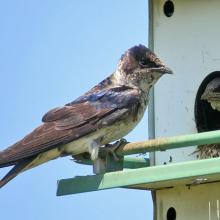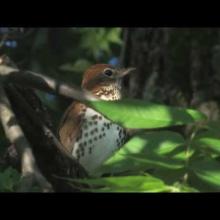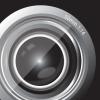

Join BirdNote tomorrow, November 30th!
Illustrator David Sibley and actor H. Jon Benjamin will face off in the bird illustration battle of the century during BirdNote's Year-end Celebration and Auction!
It’s more important than ever to map their travels – to learn when birds take flight, where they stop to rest, and what they require for food and shelter along the way. New tools like advanced weather radar, crowdsourcing, and geolocators are helping us learn more about where birds go and when.
Listen to this show in Spanish here.
BirdNote®
Tracking Migration Using Geolocators
Adapted from a script by Todd Peterson
This is BirdNote.
[Song of Wood Thrush https://macaulaylibrary.org/asset/40807]
With so many migratory birds declining at such an alarming rate, it’s more important than ever to map their travels – to learn when birds take flight, where they stop to rest, and what they require for food and shelter along the way. But until recently it was impossible to know the precise journey of a migrating bird — like this Wood Thrush.
[Song of Wood Thrush]
But now we have powerful new tools. Doppler weather radar can show birds migrating in real-time, and powerful platforms like eBird can aggregate and display millions of bird sightings by location and date.
Some of the most exciting tools scientists use are tiny, light-weight geolocators that are attached right to migrating birds. There are several variations of these devices, like ones that record light levels at sunrise and sunset, or ones that send out a GPS signal to track a bird’s exact location as it moves. The devices are so small they don’t affect the birds’ ability to fly.
[Song of Wood Thrush]
Geolocators have taught us that Wood Thrushes spend the winter in a very specific and narrow part of Honduras and Nicaragua.
Whether spring or fall, or anytime in between, learning more about birds and how they move can teach us how to help them continue these amazing long-distance journeys.
[Song of Wood Thrush]
For BirdNote, I’m Michael Stein.
###
Producer: John Kessler
Managing Producer: Jason Saul
Editor: Ashley Ahearn
Associate Producer: Ellen Blackstone
Assistant Producer: Mark Bramhill
Bird sounds provided by The Macaulay Library of Natural Sounds at the Cornell Lab of Ornithology, Ithaca, New York. Song of the Wood Thrush [40807] recorded by G.F. Budney.
BirdNote’s theme was composed and played by Nancy Rumbel and John Kessler.
© 2019 BirdNote July 2019
ID# geolocator-02-2013-07-22 geolocator-02b









